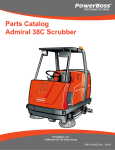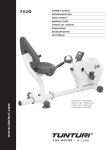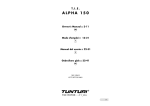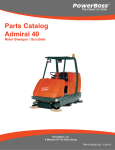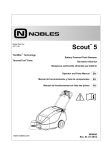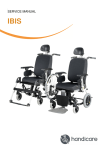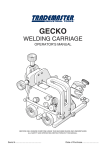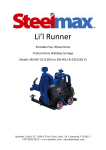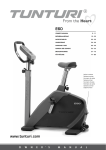Download Tunturi E5R Elliptical Trainer User Manual
Transcript
E5R OWNER'S MANUAL BETRIEBSANLEITUNG MODE D'EMPLOI MANUALE D'USO MANUAL DEL USUARIO HANDLEIDING BRUKSANVISNING w ww. tu nt ur i. co m KÄYTTÖOHJE • SERIAL NUMBER • SERIENNUMMER • NUMERO DE SERIE • NÚMERO DE SERIE • NUMERO DI SERIE • SERIENUMMER • SERIENNUMMER • SARJANUMERO OWNER'S MANUAL • E5R 1 5 2 6 2 7 3 8 4 9 OWNER'S MANUAL • E5R OWNER'S MANUAL E5R I N F O R M AT I O N A N D WA R N I N G S Please read this owner’s manual through carefully before assembling, using and servicing the workout cycle! Follow the instructions described in this manual carefully. The equipment has been designed for home and light commercial use. The Tunturi warranty applies only to faults and malfunctions in home (24 months) and light commercial use (12 months). Please note that the warranty does not cover damage due to shipping or negligence of adjustment or maintenance instructions described in this manual. N O T E A B O U T Y O U R H E A LT H • Before you start any training, consult a physician to check your state of health. • If you experience nausea, dizziness or other abnormal symptoms while exercising, stop your workout at once and consult a physician. • To avoid muscular pain and strain, begin each workout by warming up and end it by cooling down (slow pedalling at low resistance). Don’t forget to stretch at the end of the workout. NOTE ABOUT THE EXERCISING EN V I R O N M E N T • Place the device on a firm, level surface. Place the device on a protective base. • Make sure that the exercising environment has adequate ventilation. To avoid catching cold, do not exercise in a drafty place. • In training, the equipment tolerates an environment measuring +10°C to +35°C. The equipment can be stored in temperatures ranging between -15°C and +40°C. Air humidity in the training or storage environment must never exceed 90 %. • Before you start using the device, make sure that it functions correctly in every way. Do not use a faulty device. • Only one person may use the device at a time. • Wear appropriate clothing and shoes when exercising. • Do not use the device when the protective covers are not in place. • Press the keys with the tip of the finger; your nails may damage the key membrane. • Never lean on the meter. • Do not let the meter come into contact with water. Always dry the surface of the meter, if there are any drops of sweat on it. Use a soft, absorbent cloth. Do not use solvents to clean the meter surface. • Protect the meter from excess sunlight: it may fade the colors of the meter box and surface membrane. • Do not attempt any servicing or adjustment other than those described in this manual. The given service instructions must be followed carefully. • The device is not recommended for persons weighing over 150 kg or 333 lbs. A S S E M B LY Open the transport package on its side. Take the parts out of the package and make sure the package includes all the following parts: 1. 2. 3. 4. 5. 6. 7. 8. 9. Front frame Lower frame Seat frame Seat (2 pcs) Handlebar Meter Feet (2 pcs) Pedals (2 pcs) Hardware (marked with an asterisk (*) in the spare part list) NOTE ABOUT USING THE EQUIPMENT If you notice that a part is missing, contact the dealer and give the model, serial number and spare part number (the spare part list is in the back of the manual). The package includes also a silicate bag for absorbing moisture during transportation and storage. Assemble the recumbent cycle as follows (left, right, front and back are as seen from the exercising position): • Parents or others responsible for children HANDLEBAR ASSEMBLY AND SEAT should note that children’s natural playfulness and curiosity may lead to situations and behaviour for which the device is not designed. If children are allowed to use the device, they should be supervised and taught to use the device properly, keeping in mind the child’s physical and mental development and their personality. The exercise device is not a toy. GB FIG. 1 (version without hand grip pulse) Remove the seat fastening nuts. Place the seat upside down, for example, on a chair. Place the handlebar, the spacer bar and the seat frame upside down on the bottom of the seat. Fasten the handlebar and seat to the seat frame with nuts. 3 H A N D L E B A R A S S E M B LY A N D S E AT FIG. 1 (version with hand grip pulse) Remove the seat fastening nuts. Place the seat upside down, for example, on a chair. Place the handlebar, the spacer bar and the seat frame upside down on the bottom of the seat. N O T E ! Do not damage the hand grip pulse wires. Fasten the handlebar and seat to the seat frame with nuts. Attach the hand grip pulse wires to the transmitter box and push the extra wire length inside the handlebar. Detach the lid of the transmitter box, insert batteries (3xAAA) and close the lid. LOWER FRAME FIG. 2 Slide the retaining plate located underneath the seat frame to the front of the bar. Fasten the lower frame to the seat frame using the shorter M8 screw (A) in the front and longer M8 screw (B) in the back. Place the shorter screw (A) into the frame hole from the end of the lower frame and the longer screw (B) through the frame. Pass the screws through the holes in the lower frame so that they match the threads in the retaining plate. Make sure the screws are tightly fastened. FEET FIG. 3 Secure the rear foot with two M10 bolts (C) and washers (D). At this point tighten the bolts only with your fingers. Lift the cycle on the floor and turn it right side up. Fasten the front foot with the transportation wheels to the front frame the same way. JOINING THE FRAMES FIG. 4 Join the front frame and seat frame by pushing one tube inside the other so that the screw holes in the tubes match together. Fasten the frames with two M8 screws (E) and washers (F). Tighten the rear and front foot screws and push the plastic caps over the screw heads. OWNER'S MANUAL • E5R S E AT B A C K 4 FIG. 5-6 Push the fastening screw (G) through the hole in the seat frame tube and the assembly plate. Place the bushing (H) on the fastening screw and secure the plate by tightening the nut (I) on the fastening screw. Remove the fastening nuts and washers of the seat back and attach the seat back to the assembly plate with them. Finally, push the plastic caps over the nuts. METER FIG. 7-8 Remove the tape covering the wire coming out of the frame tube, and connect the wire with the connector inside the meter tube. Thread the connected wire carefully into the frame tube, and push the meter’s connecting tube into place within the frame tube so that the heads of the screws point to the seat. N O T E ! Do not remove the fastening screws, but tighten the two fastening screws of the connecting tube by pushing the allen key through the hole in the frame tube to the screw head and turning counter-clockwise. Loosen the two screws for the drink bottle rack and secure the rack in place with the screws. Remove the protecting film from the meter display. PEDALS FIG. 9 The pedals are distinguished by the markings R (=right) and L (=left). Fasten the right pedal to the right pedal crank by turning clockwise and the left pedal to the left pedal crank by turning counter-clockwise. Fasten the pedal straps. The straps are distinguished by the markings R (=right) and L (=left). Choose the strap tightness, set the appropriate strap hole on the retainer from below and pull forcibly upwards. POWER CORD Plug the transformer into the connector, just above the front support, and then the transformer cord into the wall socket. • Always unplug the appliance from the wall socket and remove the cord from the appliance immediately after use. • Make sure that the cord does not run underneath the appliance. USE CORRECT BODY POSITION The Recumbent Ergometer E5R is designed to comfortably distribute your weight evenly over your buttocks and lumbar region of your lower back. Your legs are also positioned closer to the level of your heart, allowing a less strenuous and more efficient cardiovascular workout. To ensure proper positioning please follow the recommended guidelines: the distance between the seat and the pedals should be adjusted so that your knee remains slightly bent when your leg is extended to the furthest pedalling point forward. To adjust the distance lift the lever located below the seat. Place first your feet on the pedals, then release the seat and push it to the right distance. Release the lever to lock the seat. Make always sure the seat is locked. EXERCISING WITH TUNTURI No matter what your goal, you’ll get the best results by training at the right level of effort, and the best measure is your own heart-rate. First find your maximum heart-rate, i.e. where the rate doesn’t increase with added effort. If you don’t know your maximum heart rate, please use the following formula as a guide: Women: 226 - age Men: 220 - age OWNER'S MANUAL • E5R These are average values and the maximum varies from person to person. The maximum heart rate diminishes on average by one point per year. If you belong to a risk group, ask a doctor to measure your maximum heart rate for you. We have defined three different heart-rate zones to help you with targeted training. Beginner: 50-60 % of maximum heart rate Also suitable for weight-watchers, convalescents and those who haven’t exercised for a long time. Three sessions a week of at least a half-hour each is recommended. Trainer: 60-70 % of maximum heart rate Perfect for improving and maintaining fitness. You should train for a minimum of 30 minutes at least three times a week. To improve your condition still further, increase either frequency or effort, but not both at the same time! Active trainer: 70-80 % of maximum heart rate Exercise at this level suits only the fittest and presupposes a long history of exercising. METER TU R N I N G T H E M E T E R O N A N D O F F The meter turns itself on when the device is connected to the mains current. When the meter has not been used for five minutes (no heart rate registered, no keys pressed, no pedaling), it automatically switches itself to energy-saver state. The meter is returned to its active state by pressing any key, starting to pedal or sending heart-rate signals to the unit. When you restart, the meter automatically starts from Mode function. Protect the meter from excess sunlight, because that may fade the interface box and surface membrane colors. Please also be careful not to allow the meter to come into contact with water. A sharp blow may damage the meter. PU L S E M E A S U R E M E N T WITH HAND GRIP PULSE The hand grip pulse measurement functions with the transmitter box switch in ON position. If you wish to use the Polar belt for heart rate measurement, switch the hand grip pulse to OFF position. Pulse is measured by the hand grip sensors in the handle bars. Pulse is measured when the user of E5R is touching both sensors simultaneously. Pulse measurement requires that the skin is constantly touching the sensors and that the skin is slightly moist. N O T E ! If you use a heart rate controlled exercise or if the accuracy of heart rate information is important to you, we recommend heart rate measurement with the Polar belt; unlike with the NOTE ! GB heart rate belt, the accuracy of pulse measurement may vary considerably from person to person. HEART RATE MEASUREMENT WITH THE HEART RATE BELT Attach the transmitter to the elastic strap. Adjust the length of the strap to fit snugly and comfortably. 3 . Pull the transmitter away from your chest and wet the grooved areas at its back. 4 . Check the wet electrodes are uniformly positioned next to your skin and that the Polar logo is central and upright. The heart rate belt works best when the transmitter is worn against your bare skin. If you prefer to wear it over a shirt, please moisten the shirt well under the electrodes: the contacts must be wet while you exercise. Take good care of the transmitter after you exercise. This helps to prolong the life of the electrodes and battery. 1. Wash the transmitter carefully with a mild soap-water solution. 2 . Rinse with clean water. 3 . Dry the transmitter carefully. 1. 2. FUNCTION KEYS includes constant resistance, constant effort and constant heart-rate workouts. The user interface automatically starts from the constant resistance workout. Use the operation key SET to make settings and adjustments to the user interface options. PROG includes pre-programmed exercise profiles, memory positions for your self-designed exercise profiles and measurement of recovery pulse. MODE REC AND OK Use the Rec key to save your own workouts. Press Rec before beginning the workout you wish to save. Press OK to confirm. RESET Press the Reset key for more than one second to display the cumulative values. Pressing Reset always resets the value on the display. SETTING KEYS -/+ Use the setting keys (-/+) to adjust resistance, effort and heart rate for the workout. 5 M A I N D I S P L AY When you turn the meter on, the display shows the following exercise parameters: 1. EFFICIENCY (W) Figure indicates exercise efficiency in Watts, which depends on pedaling speed and resistance adjustment. 2 . ENERGY CONSUMPTION (kcal / kJ) Displays cumulative energy consumption (0-999); default setting is kcal. 3 . SPEED (rpm / km/h / mph) Default setting is rpm (pedal revolutions / minute). 4 . PULSE Heart rate transmitter belt or an ear sensor is required. If the meter does not receive a heart-rate signal, - - is displayed instead of the heart rate. N O T E ! Always disconnect the ear sensor from the meter if using a heart rate transmitter belt; the ear sensor will interfere with the heart rate transmitter. 5. TIME Displays the exercise time elapsed between 0:00 59:59 minutes and between 1:00 - 10:00 hours in 1 minute increments. Time display stops if speed falls to zero. 6 . DISTANCE (km / miles) Default display setting is km. Displays the distance traveled during the workout in km (or miles) to two decimal points up to 9.99 km (or miles) and with one decimal point up to 99.9. FUNCTIONS A D J U S T I N G R E S I S TA N C E Resistance in constant resistance workouts is adjusted with the - / + keys. The text SET and setting value are displayed when you adjust resistance. The meter returns to the main display 2 seconds after setting the value. RESET Press R ESET to reset the values on the display. Cumulative training values are displayed by pressing R ESET for more than one second. They remain on the display for as long as the key is pressed. MODE includes constant resistance, constant effort and constant heart-rate workouts. In all workouts, one parameter is set as a constant, after which your exercise equipment automatically maintains the level. Constant heat-rate exercise requires your using the heart-rate measurement system. 1. Press MODE key to select the workout. R ESISTANCE = constant resistance exercise at the same resistance level throughout. Faster pedaling means an increase in effort. WATT = constant effort exercise; the interface OWNER'S MANUAL • E5R MODE 6 adjusts resistance automatically so the training effort set, e.g. 100 W, remains the same independent of pedaling rate. PULSE = constant heart-rate exercise; the interface adjusts effort automatically and keeps your heart-rate at the desired level, e.g. 120 beats per minute, independent of pedaling rate. 2 . Set the target level with the - /+ keys. You can adjust the target level with the - / + keys during the workout whereupon the text SET and the setting value (Nm, W, heart rate) are displayed. The meter returns to the main display 2 seconds after setting the target value. PROG includes pre-programmed exercise profiles, memory positions for self-designed profiles and measuring recovery pulse. The resistance level varies in a pre-determined way and has three options: Health = fitness improvement, Slim = weight control (HRC ; requires heart-rate measurement), Fit = profile designed for the physically fit. The level of difficulty of the selected profile can be scaled from 1 to 9. Level 1 is the easiest and longest and level 9 the most challenging and shortest. A full description of the profiles is given at the end of these instructions. PROG PRE-PROGRAMMED PROFILES (HEALTH, SLIM, FIT) Press PROG until the desired profile (Health, Slim, Fit) appears on the display. Press OK to confirm. 2 . Use the - / + keys to select the level (Level 1-9). Press OK to confirm. 3 . Start pedaling to begin the workout. 1. DESIGNING YOUR OWN EXERCISE PROFILES You can save three self-designed exercise profiles. Although the profile can be any of the MODE programs (Resistance, Watt, Pulse), the program cannot be changed during saving. A total of 30 changes can be saved in each profile. There is no time limit in the profiles. 1. Press R EC to start saving your self-designed workout. During saving the text R EC is displayed. Press OK after completing your profile. The text R EC on the display is cleared and replaced by memory position “User 1”. The flashing numeric value indicates that a profile has already been saved in the memory position. Previous profiles can be replaced by new ones, or use the - / + keys to move to other memory positions (User 1, 2, 3). Press OK to save the profile in the desired memory position. 2 . To use a self-designed exercise profile press PROG until User appears on the display. Use the - / + keys to select a memory position (User 1, 2, 3). OWNER'S MANUAL • E5R If the memory position is empty the reading 0:00 is displayed. Press OK to confirm your choice. 3 . Start pedaling to begin the workout. RE C O V E RY Measure your recovery pulse rate at the end of the workout. To measure recovery pulse rate press PROG until the text “Recovery” appears on the display. Press OK to confirm. In order to improve the reliability of recovery pulse measurement, always try to standardize the measurement situation as accurately as possible; start measuring at the same heart rate level as precisely as possible. The measurement of recovery pulse takes two minutes, during which time the current heart rate is displayed. During measuring the text “Recovery” flashes on the display. At the end of the measurement period the recovery ratio percentage is displayed. The smaller the reading the fitter you are. Note that results are individual and not directly comparable with those of others. N O T E ! If there is a problem in pulse measurement, the display will show - - instead of the heart rate, and measurement of recovery pulse will automatically restart when the user interface once again receives a heart-rate signal. Press OK to move from recovery pulse measurement to the main display. The main display will appear automatically 1 minute after the measurement. PA U S E When the user interface has not been used for three minutes (no heart rate registered, no keys pressed, no pedaling), it automatically switches itself to energy-saver state. The interface is returned to its active state by pressing any key, starting to pedal or sending heart-rate signals to the unit. The values in a workout that has been interrupted are saved in the memory of the user interface for 10 minutes, after which they are reset. The values on the display are always reset when the R ESET key is pressed. SE T To set the heart-rate limit press SET once. The lower heart rate limit is indicated by the text LO and the upper limit by HI . If desired, the user interface indicates when your heart rate falls below the lower limit or exceeds the upper limit with an alarm. To set heart rate limits procede as follows: The lower limit (LO ) may be set between 50 and 220 beats per minute. Use the - or + keys to set the value and press OK to confirm. Set the upper heart-rate limit (max. 220) in the same way as for the lower limit. Press OK to confirm. To delete heart-rate limits use the - or + key to move the values above the permitted upper or lower limit. The value is then replaced by — on the display. 2 . To select the alarm press SET twice. The text Ind 1. GB indicates that the alarms are switched off and Ind ON that they are switched on. Use the - or + keys to select OFF or ON and press OK to confirm. 3. To set units of measurement press SET three times. Default units are rpm, km and kcal. To change the units press the + or - key until the desired units are displayed. To measure speed you can set either revolutions per minute, (rpm), kilometres per hour (km/h) or miles per hour (mph). Energy consumption measurement can be set for kilocalories (kcal) or kilojoules (kJ). In addition to rpm you can also select either kilometres (km) or miles as distance measures. If km/h is selected as the unit to measure speed, km will automatically be the unit for distance. The same applies to the units mph and miles. Press OK to confirm your selections, which are then saved and indicated on the main display. Press the R ESET key to exit the setting function without saving the adjustment. This resets the readings on the main display. OFF MAINTENANCE The semi-recumbent ergometer E5R requires very little maintenance. We recommend, however, that you make sure all the fastening screws are tight after approximately one week of use. Turn the cycle on its side and tighten the screws, if necessary. From time to time check that the screws and nuts are tight. Clean the cycle with a damp cloth. Do not use solvents. Please contact your dealer immediately if you notice any defects or malfunctions while using your equipment. Please state the nature of the problem, conditions of use, purchase date and serial number of your equipment. In spite of continuous quality control, individual defects and malfunctions may occur due to individual components. It is in most cases unnecessary to take the whole cycle for repair, as it is usually sufficient to replace the defective part. TRANSPORT AND STORAGE Move the recumbent cycle according to the following instruction: stand behind the cycle and take it by the seat frame with one hand and by the handlebar with the other hand. Lift the E5R so that it rests on the transport wheels and move it by wheeling. Lower the cycle on the floor while holding on to it and remaining all the time behind the device. N O T E ! Follow the transportation instructions because lifting the recumbent cycle incorrectly may strain your back or cause other risk of accidents. To prevent malfunctioning of the cycle, store in a dry place with as little temperature variation as possible, protected against dust. 7 DIMENSIONS BETRIEBSANLEITUNG E5R Length ............ 165 cm / 65 in Height ............ 100 cm / 40 in Width .............. 67 cm / 27 in Weight ........... 63 kg / 140 lbs BETRIEBSANLEITUNG • E5R All Tunturi models are designed to meet the electro-magnetic compatibility directive, EMC and are affixed with the CE conformity marking. N O T E ! The instructions must be followed carefully in the assembly, use and maintenance of your equipment. The warranty does not cover damage due to negligence of the assembly, adjustment and maintenance instructions described herein. Changes or modifications not expressly approved by Tunturi Ltd will void the user’s authority to operate the equipment! Due to our continuous programme of product development we reserve the right to change specifications without notice. 8 WICHTIGE SICHERHEITSHINWEISE Diese Betriebsanleitung ist ein wesentlicher Bestandteil Ihrer Trainingsausrüstung. Lesen Sie dieses Handbuch daher aufmerksam durch, bevor Sie Ihr Trainingsgerät montieren, mit ihm trainieren oder es warten. Bitte bewahren Sie dieses Handbuch auf. Es wird Sie jetzt und zukünftig darüber informieren, wie Sie Ihr Gerät benutzen und warten. Befolgen Sie diese Anweisungen immer sorgfältig. Ihr neuer Heimtrainer von Tunturi wurde für das Heimtraining und die leichte kommerzielle Nutzung entwickelt. Die Garantie dieses Gerätes beträgt 24 Monate für das Heimtraining und 12 Monate für die leichte kommerzielle Nutzung. Sowohl Tunturi, als auch seine nationalen Vertretungen übernehmen keine Haftung für Verletzungen oder Geräteschäden, die sich bei Dauereinsatz in gewerblichen Fitnesscentern, Sportvereinen und vergleichbaren Einrichtungen ergeben. Für Schäden, die durch Missachtung der beschriebenen Einstellungs- und Wartungsanweisungen entstehen, besteht kein Garantie-Anspruch! • Suchen Sie vor dem Trainingsbeginn einen Arzt auf, der Ihren Gesundheitszustand feststellt. • Bei Übelkeit, Schwindelgefühl oder anderen anomalen Symptomen sollte das Training sofort abgebrochen und unverzüglich ein Arzt aufgesucht werden. • Das Trainingsgerät ist ein Sportgerät und kein Spielzeug für Kinder. Aufgrund des natürlichen Spieltriebes und der Experimentierfreudigkeit von Kindern können Situationen und Verhaltensweisen entstehen, für die das Trainingsgerät weder gebaut noch abgesichert ist und die eine Verantwortung seitens des Herstellers ausschließen. Wenn Sie dennoch Kinder an das Trainingsgerät lassen, müssen Sie deshalb deren geistige und körperliche Entwicklung und vor allem deren Temperament berücksichtigen, sie gegebenenfalls beaufsichtigen und sie vor allem auf die richtige Benutzung des Gerätes hinweisen. • Das Gerät sollte grundsätzlich nur von einer Person benutzt werden. • Das Gerät auf möglichst ebenen Untergrund stellen. • Dieses Gerät ist nicht für den Einsatz in Feuchträumen (Sauna, Schwimmbad) vorgesehen. • Vor Beginn des Trainings sicherstellen, dass das 2 5 8 93 71 62 73 6 92 91 10 4 9 65 1 13n 69 7 2 3 61 8 16 12 13m 21 20 74 15 33 13k 13a 14 72 42 43 24 70 62 75 13d 59 60 66 67 68 62 64 60 63 43 17 35 56 39 18 57 13e 54 22 41 58 13c 43 135 55 35 32 43 44 45 40 53 39 18 233 9003 User interface 1 - 2 153 9003 Seat back 1 12 503 9010 *- M8 DIN 125 Washer 4 - *- M8 DIN 934 Nut 4 13 403 1070 Cable set (incl. 13a,13d,13e) 1 3 153 9001 Seat 1 13c 403 1026 RPM-magnet 1 - M8 DIN 985 Nut nylon 2 13k 403 1071 RJ12-plug, Mod 6/6 1 4 403 1073 Receiver 1 13m 403 9004 RJ12-plug, Mod 8/8 1 5 533 7024 Handlebar plug 2 13n 403 9005 Cable 1 6 213 1004 Handle grip 2 14 683 1011 Bezel 1 7 203 9002 Handle bar (incl.. 5, 6, 8) 1 15 103 9010 Tube 1 - M8 DIN 985 Nut nylon 4 - DIN 7380 Screw 2 8 403 9006 Telemetric hand pulse 1 16 533 4047 Plug 1 - 4,2x16 DIN 7504-K PT-Screw 2 17 103 9005 Frame 1 9 433 9001 1 18 533 1050 Stand plug 4 - 4,2x16 DIN 7504-K PT-Screw 2 19 Label set (incl.19a, 19b) 2 10 173 9008 Side cover for Al-profil 1 20 173 1053 Side cover, LH and RH. 2 - M8x35 DIN 912 Screw 1 - KB 40x20 WN-1411 PT-Screw 4 - M8x50 DIN 912 Screw 2 21 533 9012 Plug 1 11 173 9009 Side cover for Al-profil 1 22 653 1017 Nut 2 - M8x35 DIN 912 Screw 1 - 12x18x05 DIN 988 Washer 1 24 303 9003 E5R Flywheel 1 1 48 38 37 36 47 Al-profil for user interface M8x50 DIN 912 Screw 2 RJ12-plug bracket 1 KB 40x20 WN-1411 PT-Screw M8x20 4213 9003 1 E5R - 17x24x1,5 DIN 988 Washer 1 - Screw 4 31 403 0022 Transformer 24VDC, EUR 1 64 503 9008 Adjusting plate 1 - 403 0025 Transformer 24VDC, USA 1 - M8x20 DIN 912 Screw 2 - 403 0027 Transformer 24VDC, UK 1 - M8x20 DIN 7991 Screw 1 - 403 0028 Transformer 24VDC, SUI 1 - M8 DIN 934 Nut 3 - 403 0029 Transformer 24VDC, ISR 1 65 153 9004 Seat frame 1 - 403 0030 Transformer 24VDC, AUS 1 - M8 DIN 934 Nut 2 32 403 1066 Control card, compl. 1 - 652 133 Washer 2 - M4x6 DIN 7985 Screw 3 M8x16 DIN 933 Screw 2 33 403 1050 El. magnet 1 Axle, upper 2 - M6x50 DIN 931 Screw 4 - M6 DIN 125 Washer 4 35 533 1046 M10 plug 4 36 673 500 88 Snap locking 2 37 533 1048 Wheel 2 38 103 1038 Front support 1 - 103 1039 compl. (incl. 18, 36, 37) 1 *- M10 DIN 125 Washer 2 *- M10x25 DIN 933 Screw 2 39 103 9006 Rear support 1 *- M10 DIN 125 Washer 2 *- M10x25 DIN 933 Screw 2 40 643 104 89 Spring 1 41 523 504 84 Bearing, flywheel 1 42 Bearing, flywheel 1 43 523 409 85 Bearing 4 44 343 1010 Flywheel axle 1 45 443 9003 Transmission belt 1 47 513 9002 Belt tightener frame 1 - 12x18x1 DIN 988 Washer 1 - 10 DIN 471A Retaining 1 53 263 1007 Pulley 1 - Retaining 1 54 353 1005 1 Crank, RH 1 - Crank, LH 1 55 653 0073 Screw-plug 2 56 363 1002 Pedal band, pair 1 57 363 1001 Pedal, pair (incl. 56) 1 58 103 9007 Rail support 1 523 1010 17 DIN 471A 353 1004 1 - M8x40 DIN 912 Screw 1 - M8x65 DIN 912 Screw 1 59 103 9009 Inner tube 1 - M8 DIN 125 Washer 2 - M8x20 DIN 933 Screw 2 60 173 9005 Rear plug 1 - M4x25 DIN 7500C Screw 60 173 9006 - Front plug M4x25 DIN 7500C Screw M8x20 DIN 913 66 343 9004 3 1 3 61 103 9011 Seat rail 1 62 533 0020 M8 plug 14 63 503 9009 Fastener plate 2 49 PROFILES • E5R PROFILES 50 PROFILES E5R PROFILES Health Slim (min) (W) (bpm) 0 80 80 1 90 90 2 90 90 3 100 100 4 110 100 5 120 110 6 130 110 7 140 120 8 140 120 9 140 130 10 140 130 11 140 130 12 140 130 13 130 140 14 130 140 15 120 140 16 120 140 17 130 140 18 130 140 19 140 140 20 140 130 21 140 130 22 140 130 23 140 130 24 140 120 25 140 120 26 130 120 27 130 120 28 120 120 29 120 120 30 130 130 Level Intensity = Level x 1 0,7 Fit (W) 80 90 100 110 130 130 140 140 140 130 130 120 120 150 150 170 170 150 150 140 140 140 150 150 180 180 150 150 140 130 130 2 0,775 (min) 31 32 33 34 35 36 37 38 39 40 41 42 43 44 45 46 47 48 49 50 51 52 53 54 55 56 57 58 59 3 0,85 Health Slim (W) (bpm) 130 130 140 130 140 140 140 140 140 140 140 140 140 130 140 130 130 130 130 120 120 120 110 120 110 120 120 120 130 130 130 130 140 130 140 140 140 140 140 140 140 140 140 130 140 130 140 130 130 120 130 120 120 120 120 110 110 110 4 0,925 5 1,0 Fit (W) 140 140 140 150 150 170 170 170 170 150 150 150 120 120 120 130 130 140 140 140 130 130 120 120 110 110 100 100 100 6 1,075 7 1,15 8 1,225 9 1,3 51 www.tunturi.co m TUNTURI OY LTD P.O.BOX 750, FIN-20361 Turku, Finland Tel. +358 (0)2 513 31 Fax +358 (0)2 513 3323 www.tunturi.com 583 9002














